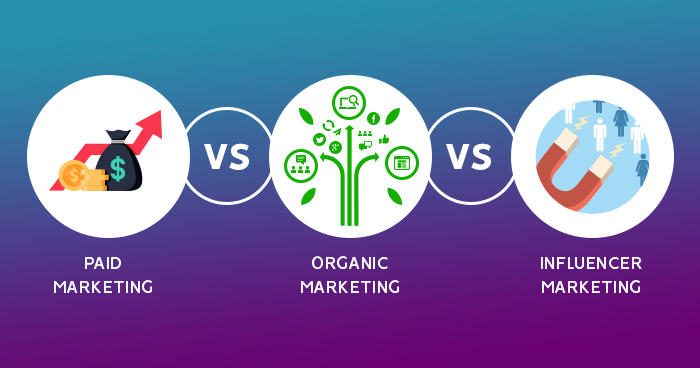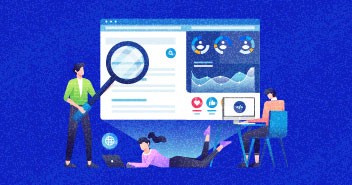
Initiating marketing of an ecommerce startup is hard, but not impossible. In this comparison piece, you will learn what are the major digital marketing channels and how you can achieve your intended outcomes by using them in the best way possible.
“Where do I begin?”
This is the question may pop into your mind when marketing your first ecommerce startup. If it is the case, then you’re not alone.
Until a few years ago, search engine optimization was the only way of marketing a business online. But today, digital marketing has branched out into several categories – such as paid, influencer, search, social, and more – all of which are in flux.
The result?
Marketing any business online has become incredibly challenging (and confusing) for a layperson. The average ecommerce store owner has to sift through and come up with a suitable marketing strategy for various digital marketing channels.
Then there’s the problem of choosing the right marketing channel: Should you choose one or integrate several?
Using only one channel may not be enough to get the right results. But combined together, and you have the problem of coordinating them to achieve the right metrics.
Three Major Types of Digital Marketing Channels
Here is a detailed look into the pros and cons of major digital marketing channels and how you can use them for your ecommerce store.
Paid Marketing
The concept of paid marketing dates back to the mid 1990s when Yellow pages gave a ‘featured listing’ to businesses that wanted to promote themselves on the website.
Google then replicated this same tactic when it established itself as a search engine in the early 2000s.
The model of paid marketing was simple: companies that wanted to be promoted through the Search Engine Results Pages (SERPs) will buy keywords for a limited duration, and Google will then give them top spots on search results.
Google would display these top spots and make them stand out from organic searches (see image below) by highlighting ‘ads’ next to the name of the companies.

Source: Marketing with Elizabeth WordPress Blog
The practice changed later on before Google rolled out its Adsense program.
Through it, Google was able to rent space on websites that had Adsense installed. As a result of this, Adwords users were able to market their companies on blogs and websites where Adsense was installed. These types of ads were called ‘Display ads.’
The business model of online ads quickly spread over to social media sites.When Facebook was launched in late 2000s, it was looking for a way to earn through all the data it had. This led to Facebook Adverts in late 2010. The idea was to target users based on their data. Though this practice was against the Federal Trade Commission’s (FTC) policy, FTC approved it as Facebook wasn’t revealing the user identity to the marketers.
Following the footsteps of Facebook, other social media channels (Twitter, Instagram, Snapchat, and even Reddit) began doing the same, starting a new age of ‘paid marketing’ as it is known today.
The following are the pros and cons of paid marketing.
Pros
- Can generate traffic, leads, and even prompt conversions almost instantly
- Precise targeting of ads based on niche, demographics, geography, and time
- Measurable ROI
- Full control of audience and ad budget
- Helps new ecommerce stores gain exposure and make sales
- Can control how much to spend on each campaign per day
Cons
- Fewer clicks than organic because people don’t trust paid ads as much as they trust organic
- Listings are temporary and can disappear as soon as the budget runs out
- Intense competition can lead to higher price bids for keywords
- Managing paid campaigns requires plenty of time and expertise
- Most of the users now use ad blockers so they don’t see the ads.
Estimated Budget
Although there is no fixed budget available for paid marketing campaigns, an average cost per click (CPC) is $1 or $2 for low volume keywords.
Google AdWords
The bid price of each keyword varies depending on its search volume. Usually, the price of a mid-volume keyword is around $2 to $4. The CPC of display ads is lower than this amount. So for getting around 1,000 clicks they spend an average of $3,000 per day.
Facebook and Instagram Ads
The cost of Facebook ads depends on the audience selected. If it’s narrow – as per the Facebook Insights tool, the cost per click will increase. But, Facebook reduces this cost when the user has a Facebook pixel installed on his website.
Suggested Digital Marketing Channels Strategy
For an ecommerce store, there is no best strategy. You will have to test and see what works for you.
Google AdWords
First, decide if you want to promote your products through Google Shopping, Display network, or Search Engine. Now, choose relevant keywords and start promoting your products.
Start with a small budget for a week to know how the campaigns are performing. If they aren’t performing as you had expected, then change your strategy by choosing different keywords. In a month or so, you will have a working strategy in place.
Facebook and Instagram
Build a brand persona and then promote your products to the audience based on that persona.
Say your target persona is a 26 year old woman who lives in New York, loves the latest fashion products, and goes to the gym.
To cater to this persona, go to Facebook Audience Insights and select women aged 24-30, who love fashion and are interested in fitness.
Now test your campaigns and alter them with time to see what works. Just like Google AdWords, spend a small amount at first to see if the campaigns are actually working as intended.
Some Statistics and Opinions
Here is what most bloggers, influencers, and digital marketing experts have to say about paid marketing and its future.
Andy Taylor writes on Search Engine Land:
“Google has been steadily making changes that directly harm organic search and help to keep paid search click growth strong.”
Ramona Sukhraj writes on Impactbnd:
“Realistically, it takes three to six months to start seeing movement in search rankings and most people just don’t want to wait that long. Paid search helps you get visitors to your website today and also speeds up the process of optimizing your landing pages for higher conversions, which pays off exponentially in the long run.”
Jaqueline Kyo Thomas writes on AudienceOps:
“Ads are easier than SEO. Let me be the first to tell you that search engine optimization (SEO) is hard. Keywords and algorithms are the stuff of nightmares. The good news with ads, especially Facebook ads, is that you don’t have to worry about that stuff. You can target your audience by demographic instead of search.”
Organic Marketing
Organic marketing is a mixture of social and search marketing. It is also called inbound marketing because visitors come to your store consistently without you having to spend a single amount of ads on them.
Organic marketing is done through two ways:
- SEO
- Social media marketing

Organic Marketing combines SEO, Social, Referral, and Direct Marketing
Organic marketing is the first kind of digital marketing that went mainstream. When search engines such as Yahoo and Google were established, they worked on keywords.
Anyone who had the knowledge of search engine optimization was able to push their website to search rankings without much effort. At the time, simply writing content around certain keywords was enough to rank it higher in the SERPs and get ample traffic.
Later on when social media websites like Orkut, Google, and then Google+, Twitter, and Pinterest emerged, people started optimizing keywords to boost their posts on social media as well. They used to write keyword optimized content on social media websites to widen reach of their posts.
Today, both of these methods combine to form ‘organic marketing’, because they drive visitors to a website naturally.
Organic marketing has now become harder, and the policies revolving them have become tougher. But, if done properly, organic marketing can help you promote your website for a fraction of the cost.
Here is a breakdown of the benefits and drawbacks of organic marketing.
Pros
- It is free. You won’t have to spend a single dime to get traffic
- Visitors trust it because the results are more relevant to them
- Rankings achieved through organic marketing are sustainable for longer
- It increases brand awareness because the visitor is looking for information and reviews
- Traffic coming through search rankings has a higher click through rate
Cons
- Attaining organic traffic is a long and tiresome process that can go for a few months
- You will have to keep producing content and optimizing it in the beginning to get noticed by search engines
- It is too competitive. Every company in the world is trying to target a single keyword. Therefore, only the best ones get to reach the top.
- There is no guarantee that your website will rank higher on search engines
- You will have to endure a large upfront cost
Budget
Organic marketing means using natural methods to drive traffic through both search engines and social media websites. That’s why, optimizing organic marketing requires a large upfront cost. It involves consistently producing quality content, optimizing it for search engines, and creating social media posts that get shared by people.
The estimated starting budget for most small businesses should be around $1000/month, keeping in mind that the company will need a content producer and a graphic designer to start with.
Suggested Digital Marketing Channel Strategy
Every content marketing team has its own marketing strategy. But, ideally, most startups taking this route need a few landing pages, a blog, a marketing funnel, and a lead magnet to get started.
This way, they will be able to continuously write quality content and make conversions through lead magnets.
They can then retarget these people through emails by setting up a marketing automation process.
Some Statistics and Opinions
Here is what most bloggers, influencers, and digital marketing experts have said in the favor of organic marketing and its future.
New Media Campaigns write:
“The article details that organic results are 8.5x more likely to be clicked on than paid search results!”
Amy Biggart writes on Conductor:
“The future of marketing is holistic and customer-first. Your responsibility as a marketer is to get your customers and prospective customers to the incredible content you are creating.”
Mark Robertz writes on SEOVendor
“While SEO seems to be the perfect plan for building your brand, one of the setbacks of this strategy is that it works in a slow-paced manner”
Influencer Marketing
Influencer Marketing is a fairly new concept in comparison with the other two. Unlike influencer marketing, influencer promotion was popular from the Orkut era. At that time, community managers used to promote various products on the markets they handled. The same was done by forum moderators, who had control over their websites. Yet, influencer marketing wasn’t as widespread as it is today.
Influencer marketing is divided into three types:
- Celebrities
- Influencers and
- Micro Influencers
Celebrities
Celebrity influencers are the big shots. They don’t interact with their fans but they are highly popular among them. They also charge a lot for the products they promote. The cost of promotion can be in thousands of dollars. Celebrities aren’t actively engaged in increasing their social following.
An example of influencer marketing on Instagram
Influencers
These are industry experts and thought leaders who have gathered a large following on social media accounts. They charge a couple of hundreds of dollars for promotion of products, and technically make a living off of it.
Micro Influencers
These are niche-specific influencers. They are also called citizen influencers because of their small clout. Most small businesses prefer micro influencers because the target market is the same. Micro influencers have followers in a couple of thousands, and they promote for a fairly low price in comparison with the other two.

According to Forrester Research, people prefer recommendations by influencers because they don’t consider them a part of the brand’s voice. Hence, trusting those more and basing their decisions on them. (Mashable)
Companies have leveraged influencer marketing for brand awareness and recognition. But, as tools exist to track the ROI of influencers, influencer marketing is now used for sales as well.
Pros
- Influencers can get you higher engagement in a short amount of time
- Finding micro influencers can be cost-effective for your business
- Influencers look authentic because their followers trust them
- Micro influencers can lead to powerful backlinks thus improving SERPs
- Referrals gained through influencers go further through the sales funnel because they trust the influencers
Cons
- There is no guarantee that the influencer marketing will bring results
- Hunting for the right influencer is a time consuming process
- KPIs of influencer marketing are hard to measure
- Forming partnerships can be difficult for small businesses
- Influencer marketing doesn’t bring consistent traffic. Therefore, you cannot succeed as a brand by capitalizing on it alone
Budget
The type of budget for influencers depends on multiple factors including their area of expertise, their followers, their engagement ratio, and the competition in their niche.
In most cases, niche influencers charge between $500 and $1,000 per post, and celebrity influencers charge between $1,000 and $50,000 per post.
Suggested Strategy
Influencer marketing doesn’t bring consistent traffic to your blog. So, it is better to complement this strategy with either organic or paid marketing channels.
Most companies prefer to run influencer marketing campaigns for a special occasion such as a launch event, a giveaway campaign, a discount campaign, and many others.
It is also better to get more micro influencers onboard for campaigns on various digital marketing channels and provide each of them with a dedicated URL to check their performance. It will allow you to filter them out and see what type of influencer marketing is actually working for you.
Some Statistics and Opinions
Here is what a few bloggers, influencers, and digital marketing experts have said about influencer marketing.
Influencer Marketing Hub writes:
“Anybody can pay an influencer to talk up their products, but if you are willing to put time and effort into building up online relationships, you may be able to have influencers help you out for free.”
Meltwater writes:
“Brands are finding it increasingly difficult to cut through the buzz and have their message heard, and so they’re turning to influencer marketing to combat the influx in content. Even an outstanding piece of quality content will go unheard if it’s not promoted properly.”
Adweek writes:
“Brands can use content from influencer marketing campaigns and select the best performing images to create an Instagram sponsored post campaign. They can also try running the ad and influencer campaigns in parallel to combine Facebook data-driven targeting with consolidation from the trusted source of influencers.”
Paid Marketing vs Organic Marketing vs Influencer Marketing [Table]
| Paid Marketing | Influencer Marketing | Organic Marketing | |
|---|---|---|---|
| Effort Required | Set campaigns and start promoting your products | Hunt for influencers and get them onboard and then start promoting your products | Optimize website, do outreach for backlinks, post regular content, increase site authority |
| Effort Duration | 1 hour | 1 day | 1 month |
| Results | Gives instant results as soon as the campaign starts | Works for a few days after the content is promoted | Results don’t appear for the first few days but if used properly, they can surpass the results received through paid and influencer marketing |
| Results Duration | Only works during the running period | Needs at least $100 for citizen influencers. Influencers with 10,000 followers or more require more spending | Takes at least three months to start showing any impact |
| Starting Cost | Can be started with just $5 for 50 link clicks or 500+ impressions | Needs at least $100 for citizen influencers. Influencers with 10,000 followers or more require more spending | Requires more than $500 for SEO optimization of a store with 100 products |
| Running Cost | ~$500/month | ~$500/month | ~$100-$200 – Decreases with time |
| Objective | Selling | Brand Recognition/ Awareness | Informational Content/ Product Awareness |
| Business Model | B2C, B2B | B2Cs mostly | B2Cs and B2Bs |
How to Leverage Paid, Influencer, and Organic Marketing Simultaneously?
Most successful ecommerce stores are leveraging paid, influencer, and organic marketing effectively to get the best results for their ecommerce stores. Ecommerce giants, such as Amazon, Jet, and Newegg are some notable examples who are making exceptional use of all three.
In fact, using all three together provides a triple-level branding exposure to potential customers, increasing their trust in the brand.
If you have recently established an ecommerce store, you should create your blogs and social media marketing accounts. Through these, you can consistently produce relevant, insightful, and attractive posts for your target audience.
At the same time, you should promote these posts through paid marketing channels to increase their social signals and rank higher on search engines for relevant keywords.
Once every few months, you should organize events to attract new customers. These can be discount events, product launches, or giveaways. You can leverage influencers to promote your products on social media channels. Here you can try micro influencers to test the market. Once these strategies get traction, go for full-scale campaigns.

Image: Vertical Measures
Bottom-Line
By now, you must have understood that using these three marketing channels in isolation can’t bring any fruitful results.
But, using all three requires a great deal of expertise (and not to forget testing). However, with consistent planning, you will reach a level of stability after which you can reap higher profits by driving more relevant leads to your ecommerce store via different digital marketing channels. Also check out the cloudways webinar on Ecommerce Growth Formula, From One-Time Buyers to Loyal Clients.
What more should we add to this paid vs organic vs influencer marketing comparison article? Let us know in the comments below.
Sajjad Shahid
Sajjad is an Ecommerce Community Manager at Cloudways. He loves helping out Ecommerce store owners, merchants and marketers in establishing their businesses and startups. Sajjad enjoys playing table tennis and cricket over the weekend.


